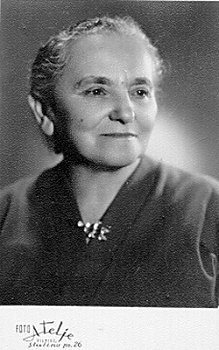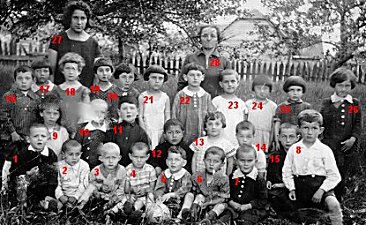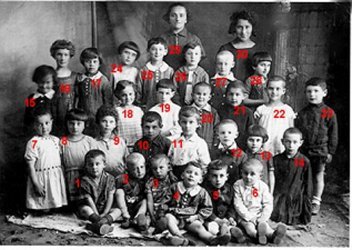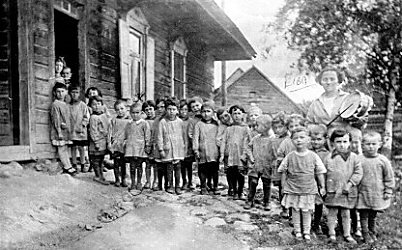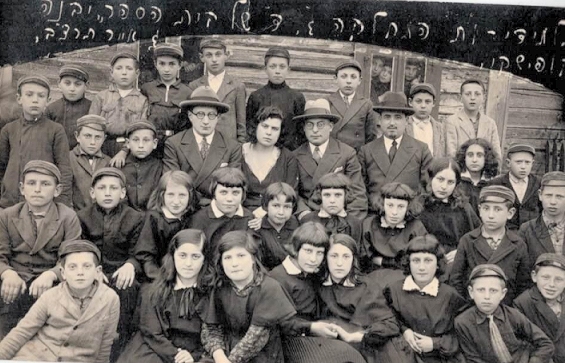 |
Kupiskis School Photos |
|
Kupishok Folkshul Children's Garden School |
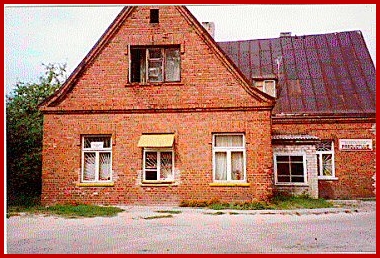
(photo courtesy of Norman Meyer) |
|
|
|
Education was very important in Kupiskis from the very
youngest kindergarten scholars to the yeshiva bocher and adults
involved in continuing religious education. One of the Kupiskis
teachers, Leibe Jakobson, personifies the dedication and caring that the
teachers of the shtetl exhibited towards their students. |
|
Leibe was born at the turn of the century in Trakai, Lithuania, a town located
in the Panevezys District, not too far from Kupiskis. Her parents were
Movsha-Israel ben Faivush Jakobson (the youngest brother of Joe Winston's
grandmother) and Chaia bat Gutman Block. She took her teaching
certificate at the Jewish School in Kaunas, which was under the direction of S.
Levinas. She began her studies in 1925 and she graduated in 1927. |
|
Her teaching certificate, written in Yiddish and Lithuanian, is shown below and
it specifies the subjects she took and the grades given. Her courses were
a combination of secular subjects such as Math and Music and Jewish subjects
such as Jewish History. The grading system was on a scale of 5 (the
highest) to 1 (the lowest). As you will see, Leibe got average grades of
either 3 or 4. The certificate was signed by Elena Chackelyte who
was a well-known Jewish educator in Kaunas and who sat on what was called the
Pedogogy Board and A. Muzaite, who was Lithuanian. |
Despite her average grades, Leibe proved to be an excellent kindergarten teacher who the students loved and remembered throughout their lives. At the time when the Germans invaded Lithuania in 1941, Leibe managed to gather a number of her students and carry them away on the last train out of Kupiskis that was going into Russia. She took care of these children and when the War was over, she returned with them to Vilnius where she became involved in teaching in the Jewish School and Orphanage there. The school was run by Colonel Joseph Rebelski who was known as the "father of the orphans".
It is everyday people like Leibe who became the real heroes of the War. Their innermost resources were stretched and tested to the maximum and they gave the best that they had. Leibe’s bravery is mentioned in a book published after the war in Vilnius by Leizer Ran, which is also referred to in the book published in New York in 1974 entitled "Jerusalem de Lita", Volume II, page 528. When she died in 1972-73, Leibe was buried in the Vilnius Jewish Cemetery in a special grave.
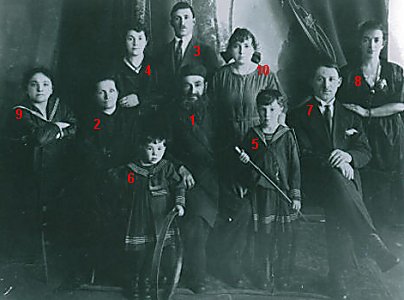
The photograph above depicts the family of Liebe "Luba" Jakobson, who originally came from Raguva and then moved to Panevezys. A number of the family also lived in Kupiskis. The picture was probably taken in Panevezys. (1) Movsha ben Faivush ben Israel Jakobson; (2) Chaia-Malka bat Guttman Block Jakobson, wife of Movsha Jakobson; (3) Guttman "George" Olkenitzky (later Alkin); (4) Pia bat Movsha Jakobson Olkenitzky (later Alkin); (5) Gitta "Jean" Olkenitzky (later Alkin) Bernadt; (6) Basheva "Sylvia" Olkenitzky (later Alkin) Close; (7) Shmuel ben Abraham Munitz; (8) Tzila bat Movsha Jakobson Munitz; (9) Luba "Leibe" bat Movsha Jakobson; (10) Fruma "Fanny" bat Movsha Jakobson Kolevsohn
Leibe never married or had children of her own, but her memory lives on in the hearts of her former students, relatives and friends, who survived the Holocaust.
(Certificate donated by Joseph Winston, the great grandson of Velvel Ribak, who obtained the certificate in Vilnius.
Photo of Leibe Jakobson donated through the generosity of Dov Levin, Hebrew University, Jerusalem, Israel.)
The following school photographs represent a group of Kupiskis children who were probably born between 1920-1925 and attended classes taught by Leibe Jakobson and her assistant Rochel Shur. Many of these children were killed during the Holocaust, but a few survived the War by fleeing with their families into Russia or had left Kupiskis with their families prior to 1941 for South Africa. (The identifications have been made by Lily Kahn Marcus, Fanny Rieback Hadassin, Sara Paul Courant, Helen Paul Knight.)
These photographs are a poignant reminder that many of the Jews killed in Kupiskis and the rest of Lithuania during the War were innocent children such as these. This section of the Photograph Album serves as a memorial to them and the future that was not to be theirs.
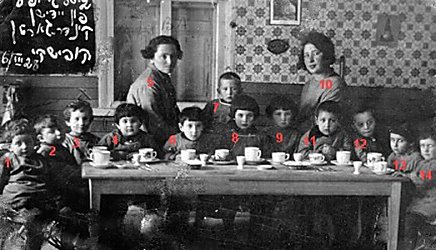 |
|
March 6, 1928 Kindergarten class Top row, left to right: (5) Leibe Jakobson (teacher); (10) Rochel Shur (teacher) Bottom row, left to right: (1) Sara Paul Courant; (4) Esther Rieback Hadassin; (9) Fanny Kagan (Kahn) Eisman; (11) Dvora (Dora) Traub Fleischman. |
![]()
|
[Photos donated by Joe Winston and Ester and Fanny Rieback (the Rieback sisters are in the photos).] |
March 6, 1928 Kindergarten class
Top row, left to right, (1)Unknown teacher's aide, (7) Leibe
Jakobson (teacher). |
|
This is a photo of the
Kindergarten Class taken in the summer of 1928 with teachers Rochel Shur, top
left and Leiba Jakobson, top right. The children would have been anywhere
from ages three to seven years of age. Some of the children are wearing a
standard black smock with lace collar and others just everyday clothes.
Notice that some of the children have cropped hair. This
may have been done to prevent or eradicate lice or other things that the
children were apt to catch. |
|
|
Some of the children in the photo are: |
|
Top Row, left to right, (20) Fanny Kagan (Kahn) Eisman; (21) Dvore (Dora) Traub Fleischman; (26) Fanny Rieback Fluxman. Middle Row, left to right, (10) Benjamin Kagan (later Kahn). Bottom Row, left to right, (5) Sara Paul Courant; (7) Esther Rieback Hadassin. |
|
Both Rieback children were born in Malat, but went to school in Kupishok before leaving for South Africa in 1929 while the Kagan (later Kahn) children were born and went to school in Kupishok before leaving for South Africa in 1930. |
![]()
|
|
|
This photo appears to be taken the same day as the one
appearing above, but, perhaps, in the photographer's studio. The
teachers are Leiba Jakobson, top left, and Rochel Shur, top right. |
|
This photo was taken from Kupishok to Capetown, South Africa by Nossen-Beinis ben Mordkhel-Leiba Kagan and Pese-Chaia Reznik. Two of their children are in the photo: top row, (26) Fanny Kagan, born 1922 and (27) Benjamin Kagan, born 1923. Other children who have been identified are: (4) Sara Paul Courant; (5) Israel Gershuni; (15) Fanny Rieback Fluxman; (20) Esther Rieback Hadassin; (24) Dvore (Dora) Traub Fleischman; (25) Helen Paul Knight.
(This photo was donated by Lily Kahn Marcus, formerly of Cape
Town, now Chicago, sister of Fanny and Benjamin).
|
|
| Yavneh School |
| The Yavne School in
Kupiskis was a religious Zionist school. The date for this photo of
the school that Dave Kahn’s grandfather attended is May, 1932, which
makes it prior to 1941 when the Jewish population was destroyed
during the Holocaust. Unfortunately, none of the names of the
teachers or students are documented. You may note though the caps that the boys are wearing and the hats the teachers are wearing as well. Most of he girls have what was considered stylish “bangs” for their hairdo. However, one girl happens to have curly hair and no bangs. The school itself is made of wood planks as you can see and other children are peeping through the windows in back of the children having their picture taken. |
|
|
Back to Main School, Youth Group, and Sports Photos


